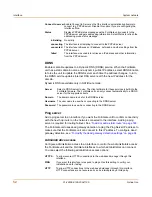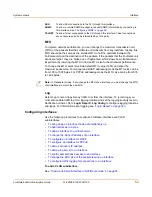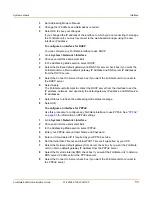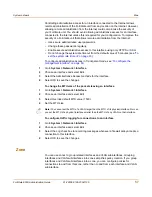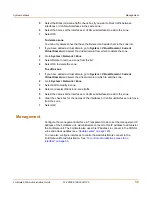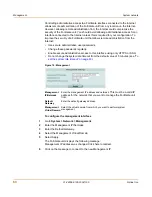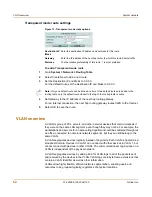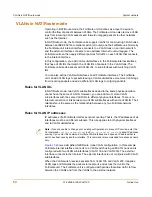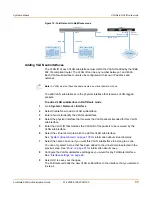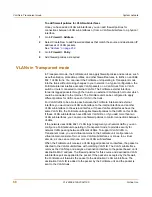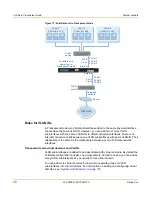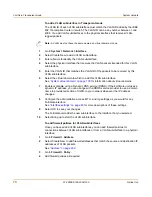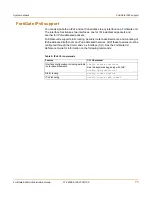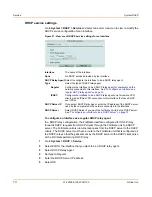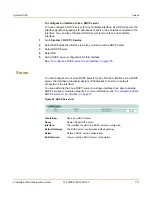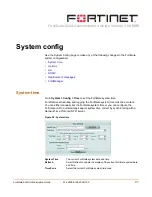
66
01-28006-0100-20041105
Fortinet Inc.
VLANs in Transparent mode
System network
To add firewall policies for VLAN subinterfaces
Once you have added VLAN subinterfaces you can add firewall policies for
connections between VLAN subinterfaces or from a VLAN subinterface to a physical
interface.
1
Go to
Firewall > Address
.
2
Select Create New to add firewall addresses that match the source and destination IP
addresses of VLAN packets.
See
“Address” on page 202
.
3
Go to
Firewall > Policy
.
4
Add firewall policies as required.
VLANs in Transparent mode
In Transparent mode, the FortiGate unit can apply firewall policies and services, such
as authentication, protection profiles, and other firewall features, to traffic on an IEEE
802.1 VLAN trunk. You can insert the FortiGate unit operating in Transparent mode
into the trunk without making changes to your network. In a typical configuration, the
FortiGate internal interface accepts VLAN packets on a VLAN trunk from a VLAN
switch or router connected to internal VLANs. The FortiGate external interface
forwards tagged packets through the trunk to an external VLAN switch or router which
could be connected to the Internet. The FortiGate unit can be configured to apply
different policies for traffic on each VLAN in the trunk.
For VLAN traffic to be able to pass between the FortiGate Internal and external
interface you would add a VLAN subinterface to the internal interface and another
VLAN subinterface to the external interface. If these VLAN subinterfaces have the
same VLAN IDs, the FortiGate unit applies firewall policies to the traffic on this VLAN.
If these VLAN subinterfaces have different VLAN IDs, or if you add more than two
VLAN subinterfaces, you can also use firewall policies to control connections between
VLANs.
If the network uses IEEE 802.1 VLAN tags to segment your network traffic, you can
configure a FortiGate unit operating in Transparent mode to provide security for
network traffic passing between different VLANs. To support VLAN traffic in
Transparent mode, you add virtual domains to the FortiGate unit configuration. A
virtual domain consists of two or more VLAN subinterfaces or zones. In a virtual
domain, a zone can contain one or more VLAN subinterfaces.
When the FortiGate unit receives a VLAN tagged packet at an interface, the packet is
directed to the VLAN subinterface with matching VLAN ID. The VLAN subinterface
removes the VLAN tag and assigns a destination interface to the packet based on its
destination MAC address. The firewall policies for this source and destination VLAN
subinterface pair are applied to the packet. If the packet is accepted by the firewall,
the FortiGate unit forwards the packet to the destination VLAN subinterface. The
destination VLAN ID is added to the packet by the FortiGate unit and the packet is
sent to the VLAN trunk.
Summary of Contents for FortiGate FortiGate-500A
Page 24: ...24 01 28006 0100 20041105 Fortinet Inc Customer service and technical support Introduction...
Page 46: ...46 01 28006 0100 20041105 Fortinet Inc Changing the FortiGate firmware System status...
Page 72: ...72 01 28006 0100 20041105 Fortinet Inc FortiGate IPv6 support System network...
Page 80: ...80 01 28006 0100 20041105 Fortinet Inc Dynamic IP System DHCP...
Page 110: ...110 01 28006 0100 20041105 Fortinet Inc FortiManager System config...
Page 116: ...116 01 28006 0100 20041105 Fortinet Inc Access profiles System administration...
Page 134: ...134 01 28006 0100 20041105 Fortinet Inc Shutdown System maintenance...
Page 248: ...248 01 28006 0100 20041105 Fortinet Inc CLI configuration Users and authentication...
Page 324: ...324 01 28006 0100 20041105 Fortinet Inc CLI configuration Antivirus...
Page 386: ...386 01 28006 0100 20041105 Fortinet Inc Glossary...
Page 394: ...394 01 28006 0100 20041105 Fortinet Inc Index...

